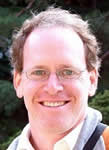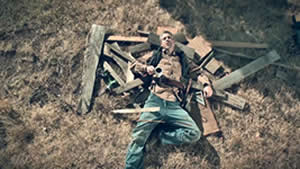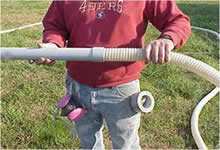
Paul Francisco Views Ventilation as a Quality of Life Issue
 |
Paul Francisco remembers his “Wow!” moment. |
program’s focus on supply leaks, the crew went into the attic and sealed the top of the wall cavity. “Those people were the happiest people I have ever seen with regard to our studies,” he recalls.
Mr. Francisco, who had been doing research in energy retrofits in homes for a number of years, turned his attention to indoor air quality. He is a research engineer and program coordinator at the University of Illinois Indoor Climate Research and Training Program (ICRT), Champaign. The new 6,700-square-foot ICRT weatherization training center opened in October. ICRT is part of the Illinois Sustainable Technology Center.
Many homeowners easily understand the value of energy efficiency and are willing to make improvements that will save energy and money. However, getting them to appreciate proper ventilation and air quality can require persuasion. Frequently homeowners ask if it is worth spending money on ventilation.
“We are trying to save energy, but we do need to consider other aspects of how people are living in their homes and other aspects of their lives besides energy bills. We need to have a balance,” Mr. Francisco says, emphasizing quality of life issues.
“The biggest challenge is convincing them there are really good reasons to spend money on ventilation when they are not detecting indoor air quality problems. Some problems we can sense and some we can’t,” he says.
Often people do not realize their indoor air may contain particles from cooking, formaldehyde from carpeting and pressed wood products, and organic compounds in cleaning products and paints. Mr. Francisco recalls a resident who complained about always having the flu. In an effort to keep warm, the resident huddled around an unvented kerosene heater and did not recognize that combustion products, such as carbon monoxide, could be causing the flu symptoms. “Many people simply do not understand the role that the contents of their homes can have on air quality and their health,” he says.
Mr. Francisco addresses these and other issues through his work as vice chair of the American Society of Heating, Refrigerating, and Air-Conditioning Engineers, Inc., (ASHRAE) 62.2 technical committee. He is involved in setting national policies and standards for residential building indoor air quality. Ventilation standards are revised on a regular basis and now receive more attention than in previous years, particularly in low-rise residential buildings.
“This is a topic I have a lot of interest in. I enjoy being part of the process,” says Mr. Francisco, who believes his work with the ASHRAE 62.2 standard committee is time well spent.
“The new standard addresses a wide range of concerns,” says Mr. Francisco. The original standard was extremely cumbersome for existing homes. It required a whole-house ventilation fan and fans in every bathroom and kitchen.
“In existing homes, it is much more difficult to install ventilation fans because you don’t have access to cavities the way you do with new construction,” he explains. In many cases, the recently revised standard allows for installation of a single fan large enough to move air throughout the house. “While not easy, this solution is certainly one that is less expensive,” he says.
His work with the Indoor Climate Research and Training Program focuses on research and training on comprehensive building performance in residential buildings. The program has researched air leakage, moisture issues, durability, ventilation, indoor air quality, and lead safety.
In the facility’s new classrooms and hands-on lab, program staff members conduct the training and certifying of assessors, final inspectors, and contractors who work in the Illinois Home Weatherization Assistance Program. Funding for the new training center was provided by the American Recovery and Reinvestment Act and the Illinois Jobs Now! construction program.
Weatherization Professionals Need
Effective Communication Skills
 |
“The person living in the house knows better than anyone else what the problems are, so it is important to listen to what the homeowner has to say,” says Raoul Moore, Energy Specialist, Indiana Community Action Association, Indianapolis. |
installers have not developed the skill set to carry out effective communications.
“They may be very good mechanically, but a lot of them are not verbal,” Mr. Moore says.
In his training classes, Mr. Moore emphasizes why students need to listen to clients and ask questions about what problems they might have with drafts, malfunctioning furnaces, or other issues. Weatherization professionals can use the opportunity to inform homeowners about energy efficiency measures. Homeowners are more likely to follow through on improvements when they understand the benefits and tasks to be undertaken.
At the beginning of a visit with homeowners, Mr. Moore makes “small talk” to form a bond with the clients to build trust and camaraderie. He keeps the clients involved throughout the weatherization process and, before he completes the job, he reviews an energy saver tip sheet with the clients to encourage proper maintenance. Throughout the process, he engages in active listening and focuses his attention on the client.
Learning about Effective Client Interactions
Marilou Cheple agrees with Mr. Moore, saying, “Tech people are often not people of words.” She found a solution to the communication gap this year. Through her work as Weatherization Supervisor with the Minnesota Department of Commerce in Minneapolis, Ms. Cheple oversaw a pilot program to enhance face-to-face communication skills among weatherization workers.
“The pilot program was received in a very positive manner. People know client communication could use improvement,” says Ms. Cheple. The program moves forward in January 2013 when nearly 90 people from the Minnesota Weatherization Assistance Program will be enrolled in training.
The client education training begins with the proper way to greet the homeowners and ask questions about their home and weatherization needs. Then, the weatherization process and the homeowners’ role are explained, supplemented with useful explanations about energy conservation practices, health and safety measures, and use of newly installed equipment.
“We have found that if clients feel good about the work, and if they are engaged, they feel more responsible for carrying out energy-saving measures,” says Ms. Cheple.
The day-long training session ends with ways to manage challenging situations, such as complaints. Coaches use role-playing and small group activities to build self-assurance and address mannerisms and issues, such as improper tone of voice. They suggest ways to show engagement: making eye contact and addressing comments.
The client education training for the Minnesota Weatherization Assistance Program will be required for auditors and inspectors, and it will be recommended for coordinators and directors. The project was made possible by a grant from the U.S. Department of Energy and the Minnesota Department of Commerce through the American Recovery and Reinvestment Act.
Relating to Homeowners
For Jeffrey Granger, it’s all about “putting yourself in the shoes of the homeowners.”
“The example I use in the classroom is ‘has this ever happened to you? A repairman is late. How does that make you feel?’ This is one way we can directly relate to homeowners,” says Mr. Granger, Trainer, New Mexico Energy$mart Academy, Santa Fe.
He tells students to always call the homeowners if they run late, explain what happened, and acknowledge the inconvenience their tardiness may have caused.
“We spend quite a bit of time in classes telling them how to deal effectively with clients. Number one: Make them feel comfortable with you,” he says. Mr. Granger instructs them to be respectful and nonjudgmental of people, their property, standard of living, and lifestyle. He insists they keep the work area clean and cover any furnishings that could be soiled during installation.
Mr. Granger keeps communication flowing among the auditor, homeowner, and crew leaders. As a courtesy to the homeowners, he avoids using acronyms and technical terminology. The goal of the conversation is to have the clients understand the information, put the information into action, and feel positive about the experience.
In addition to reinforcing interpersonal communication skills while in the classroom, New Mexico Energy$mart Academy offers an online communication training class.
WxPlusHealth.org Is Live
 |
The Weatherization Plus Health website, WxPlusHealth.org, is now available for use. This user-friendly website offers resources and strategies to find and connect weatherization professionals and community leaders to potential partners.
The website’s interactive mapping tools display information about Weatherization Assistance Program and Healthy Homes providers within any specified area in the United States. It also has network news, training tools, and best practices related to health, safety, and energy efficiency issues.
NYSWDA Assists Two Training Facilities
Weatherization professionals with the New York State Weatherization Directors Association (NYSWDA) worked in cooperation with Hudson Valley Community College and Erie Community College to establish additional weatherization training facilities. The community colleges had training programs in place, but the programs were enhanced through a two-year effort with NYSWDA. Training specialists with NYSWDA will teach at both facilities.
The opening of a pressure house training facility at Hudson Valley Community College in Troy, New York, gives a boost to students enrolled in weatherization and home energy efficiency training programs. From the outside, the building looks like a typical suburban home, but inside it is uniquely constructed to serve as a training facility for those enrolled in the building science field. The facility opened in late October.
“This facility will allow all of us to train hard skills in a real-world atmosphere, and we are excited to be able to bring more training to this part of the state,” says Andy Stone, Executive Director, NYSWDA.
Courses, which focus on teaching the “whole house” approach to energy efficiency, are aimed at achieving progressive certifications from the Building Performance Institute.
Students enrolled at Erie Community College in Buffalo, New York, are benefiting from a new facility for the Green Building Technology Certificate Program. They utilize innovative technologies for installing and testing structural building components, HVAC systems, and plumbing systems.
Erie Community College and Hudson Valley Community College are members of the 64-campus State University of New York system.
BCCAP Withstands Sandy’s Winds
Hurricane Sandy caused considerable disruption in power, phone, and Internet service for the Bergen County Community Action Partnership (BCCAP) in New Jersey. The Hackensack and Garfield centers were out of operation for about a week in late October and early November.
“We had a backup plan and were ready with generators,” says Figen Tabakci, Director of Education and Training, indicating operations have returned to near-normal. BCCAP buildings, including the recently opened Weatherization and New Green Technology Training Center, were spared from major damage.
BCCAP and 1st Bergen Federal Credit Union are establishing a SAFER fund (Sandy Aftermath Fund for Economic Recovery) to help individuals, families, and small businesses in New Jersey that were severely impacted by Hurricane Sandy.
Now Showing on WxTV:
OSHA Hazards: Fall Protection
 |
Falls are the number one cause of fatalities at job sites. Learn to prevent falls by finding out how to install an anchor, use locking mechanisms, adjust a harness for proper fit, and inspect equipment for rips or wear. To view this episode, visit www.wxtvonline.org.
On the Horizon
Renewable Energy World Conference
December 11-13, Orlando, Florida
Weatherization Plus Health Regional Training
December 11-13, San Diego, California
ACI Northwest Home Performance Conference
February 5-6, 2013, Seattle, Washington
NASEO State Energy Policy and Technology Outlook Conference
February 5-8, 2013, Washington, DC
NASCP Mid-Winter Training Conference and Orientation
February 25-March 1, 2013, Arlington, Virginia
Residential Energy Services Network Conference
February 27-March 1, 2013, Orlando, Florida
Better Buildings: Better Business Conference
March 6-8, 2013, Wisconsin Dells, Wisconsin
Weatherization Plus Health Regional Training
March 12-14, 2013, Kansas City, Missouri
ACEEE/CEE National Symposium on Market Transformation
March 24-26, 2013, Washington, DC
JTA-aligned Quality Control Inspector Module Is Ready
Weatherization professionals now have access to the quality control inspector module through the Weatherization Assistance Program Technical Assistance Center link: http://waptac.org/WAP-Standardized-Curricula/Quality-Control-Inspector.aspx. Each of the module’s 10 chapters concludes with quizzes and answer keys so instructors can do a knowledge check to identify gaps in learning.
The quality control inspector module is the third of four modules that have been revised and updated. The weatherization installer/technician module and the crew leader module are already available. The completion of the energy auditor module is expected in early 2013. These resources are of high interest to the weatherization network, and they are provided at no cost.
The four modules align with the National Renewable Energy Laboratory Job Task Analyses (JTAs) for the new national worker certification. The modules are part of the Department of Energy's Weatherization Assistance Program Standardized Training Curricula.
Accreditation Workshop
Draws 14 Participants
Fourteen participants from eight Weatherization Training Centers attended an accreditation workshop focused on meeting the Interstate Renewable Energy Council (IREC) ISPQ Standard. The workshop was sponsored by the Department of Energy and coordinated by Oak Ridge Institute for Science and Education. It was held November 13-15 in Oak Ridge, Tennessee.
Three webinars preceded the workshop to supply information for completing the accreditation applications. During the final webinar, Laure-Jeanne Davignon and Brian Mattiske of the IREC staff answered specific questions about the Credentialing Management System.
Using a tier-by-tier approach during the workshop, participants moved through the accreditation application process. Instructors were Tony Hupp and Sam Daugherty, Training Specialists with Oak Ridge Institute for Science and Education. Rand Spinney, Director of Quality, Oak Ridge Associated Universities, gave a presentation about ISO 9001, the International Standard for Quality Management Systems. It relates to Tier 3’s requirement for a documented management system.
Participants engaged in an online question-and-answer session with two recently accredited centers, New River Center for Energy Research and Training and Pulaski Technical College.
“The workshop went very well. It was very nice to talk to our peers and compare notes. I found it very useful and got quite a bit done on our application,” says Andy Stone, Executive Director, New York State Weatherization Directors Association (NYSWDA).
Mr. Daugherty noted that two months ago several participants were skeptical that they would be prepared to hand in an application before the end of the year. “But after the workshop, they said it was a possibility because the workshop was a good environment for them to focus on the task.” Mr. Daugherty and Mr. Hupp will assist training centers with follow-up activities to complete their applications.
A second accreditation workshop is planned for early spring.
Pulaski Tech Receives
IREC Accreditation
Pulaski Technical College of North Little Rock, Arkansas, is now fully accredited as a Retrofit Installer Technician training program by the Interstate Renewable Energy Council (IREC). It received the award letter in November.
“We are delighted that Pulaski Technical College has achieved IREC ISPQ Training Program Accreditation for the Retrofit Installer Technician training,” says Pat Fox, Director of Operations, IREC. “Successfully completing the assessment process has demonstrated Pulaski’s commitment to quality training to prepare an effective workforce,” she says.
“Being an accredited training program will make new financial support available to students because some funding streams can only be accessed for accredited programs. Accreditation also opens doors for us to partner with other programs and leverage our resources,” says Roger W. Smith, Director, Weatherization Training Center, Pulaski Technical College.
Safety Tip: Taking the Zap
out of Tube Filling
 |
Have you been on the receiving end of a static electrical charge while tube-filling a mobile home belly or roof cavity?
A commonly used insulation method for filling these closed cavities is to blow loose fill fiberglass insulation through connected segments of schedule 40 PVC plumbing drain pipe or electrical conduit. A static electrical charge tends to build up as air and insulation product rush through the interior of the pipe. Its effect can range anywhere from raising the hair on your arm to a painful electrical shock. Although not life threatening due to low amperage, a high-voltage discharge from a PVC pipe can be very painful.
One of the best methods to significantly reduce static electricity is to use thin-walled schedule 20 semi-rigid PVC tube, which is designed for central vacuum systems. Manufacturers and suppliers of these systems recommend this material over schedule 40 PVC for improved air flow and code compliance. Look for 1.5-inch piping that displays the IAPMO UMC Shield logo (ASTM F2158); it is available from companies such as Nutone, Honeywell, and Hoover.
Trainers’ Consortium:
Choose Your Topic
Participants on the next Trainers’ Consortium call will “grab the mic.” Facilitator Kelly Cutchin will ask “What do you want to talk about?” and lead a brainstorming session for topics for the coming year. The call is set for 3 p.m. (EST) on December 4. The next call will be at 3 p.m. (EST) on January 8.
